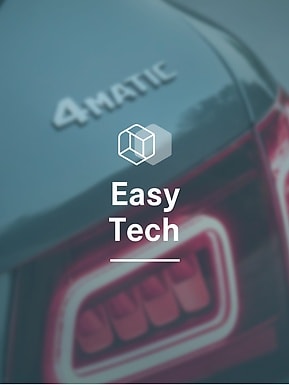06:30 a.m., Departure from Stuttgart. On the way to Immendingen, 135 kilometers away, there is plenty of time for theory. “At Mercedes-Benz, the all-wheel drive named 4MATIC was first used in 1985 in the 124 series, in which we had a permanent all-wheel drive system for the first time as a unique selling point for this vehicle class,” explains Ralf Koesling. At Mercedes-Benz Cars, he and his team are responsible for the development of all-wheel drive systems for all Mercedes-Benz models equipped with 4MATIC. “Since then, the system has been continuously developed and we are now offering one of the most innovative all-wheel drive systems on the market.” But how does a four-wheel drive work? What exactly distinguishes a four-by-four from a four-by-two?
Easy Tech: The Mercedes-Benz All-Wheel Drive 4MATIC

Four times Four.
Steep serpentines, extreme gradients and gravel roads - in the best case all at the same time. This is the ideal terrain for 4MATIC, the four-wheel drive system from Mercedes-Benz. Let’s find out how it works at the test and proving ground in Immendingen.
Content
- How does the four-wheel drive 4MATIC work?
- 1. Torque-on-demand: Variable four-wheel drive in the compact car family
- 2. Permanent all-wheel drive in C-/E-/S-/V-Class and GLC
- 3. Torque-on-Demand or permanent all-wheel drive in GLE and GLS
- 4. The G-Class: Off-Road G-rip
- 5. Traction at the physical limit: AMG Performance All-Wheel Drive 4MATIC+
How does the four-wheel drive 4MATIC work?
Driving is pure physics. The traction, or the grip of the wheels on the ground, decides between controlled rolling or a chaotic spinning. If a high driving power is applied on the wheels due to strong longitudinal acceleration, the traction quickly reaches its limits. If one wheel loses contact with the ground - experts call this a “slip” - the car can no longer move forward or, in the worst case, goes into a skid. In the case of the all-wheel drive this is different: Because a so-called transfer case distributes the driving power to both axles and to all four wheels instead of just two.
In combination with the driving dynamics control systems ESP® (Electronic Stability Program), ASR (Anti-Slip Control) and the electronic traction system 4ETS, the all-wheel drive ensures superior and predictable driving performance. Because what these systems have in common is that they avoid or rather detect and limit the wheel slip with the aid of sensor information (for example about the rotational speed of the wheels). This means that if one or more wheels spin because they are loosing traction, they are braked automatically and the driving power is instead directed to the wheels with enough traction.
This is how the all-wheel drive 4MATIC ensures dynamic propulsion on paved roads and the best possible traction off-road across all Mercedes-Benz model series.
08:00 a.m., Meeting point in Immendingen at the test and proving ground. Let’s hit the road for some driving maneuvers! Ralf and his team prepared several on- and off-road maneuvers with various Mercedes-Benz models, including a GLA 4MATIC, an E-Class 4MATIC All-Terrain and a GLE 4MATIC with an Off-Road package. Because 4MATIC does not equal 4MATIC. The four-by-four at Mercedes-Benz distinguishes between five different transfer case systems. Why? Because 4MATIC has to meet the requirements and technical prerequisites of all vehicle classes: an A-Class on wet roads in the city as well as a GLE in snow and ice during a skiing holiday. And a G-Class off-road as well as a Mercedes-AMG E 63 4MATIC+ (combine fuel consumption: 11.6 l/100 km; combined CO₂ emissions: 267 g/km¹) on the race track.
1. Torque-on-demand: Variable four-wheel drive in the compact car family
We begin our first driving maneuver with the GLA 4MATIC. In the compact car family – the A-Class, B-Class, CLA, GLA and GLB – a so-called torque-on-demand system is used. Excessive torque at the front wheels is, depending on the slip, transferred to the rear wheels on-demand. “On-demand means that the transfer case distributes the torque variably from the front axle to the rear axle and not in a specific ratio” explains Robert Nitsch, who is in charge of the compact cars in the 4MATIC team. “The torque is thus optimally distributed according to the demand and the selected driving program. With this, even hill-starting on icy roads is not a problem.”
No sooner said than done. At the proving ground, Robert simulates a hill-start in which the front axle is unable to build traction on a slippery surface such as mud, snow or ice by driving a so-called µ-jump maneuver. Therefore, the front wheels of the GLA 4MATIC are on a roller track. When starting with a gradient of 20 percent, the front wheels immediately start spinning on the rolls, while the rear wheels have traction on the firm ground. “To compensate for the slippage on the front axle, 4MATIC provides more torque to the rear axle,” explains Robert. In this way, the rear wheels push the GLA and allow it to start uphill comfortably.
2. Permanent all-wheel drive in C-/E-/S-/V-Class and GLC
In contrast to the compact car family, a permanent all-wheel drive system is used in the current models of the C-Class, E-Class, S-Class and V-Class as well as in the GLC. This means that the torque is not distributed variably, but in a specific ratio of 45 to 55. Meaning: 45 percent of the torque is directed to the front axle and 55 percent to the rear axle. “This fixed distribution of torque is characterized by excellent driving stability and traction at all times,” explains Ralf at the wheel of the E-Class All-Terrain, as he drives it uphill on the serpentine course in Immendingen.



“You can see how track-stable the vehicle remains even in tight corners at high speed. Especially when the inside wheel on the front axle can’t deliver torque, the rear axle immediately ensures driving stability and safety.” No matter whether in dry, wet, snowy or icy conditions. “You can imagine the advantages compared to a 4x2 system where only one axle is driven.” Ralf is especially proud of the modular transfer case, which was developed for the flexible use across these model series: “This is a unique selling point that is the envy of many.”
3. Torque-on-Demand or permanent all-wheel drive in GLE and GLS
We leave the serpentines behind us and (finally!) head out to the off-road course with the GLE. Three different 4MATIC systems are available for the Mercedes-Benz SUVs GLE and GLS. In the four-cylinder engines, a permanent all-wheel drive system with a fixed distribution of 50 percent on the front axle and 50 percent on the rear axle. And starting with the six-cylinder engine, as well as in the plug-in hybrid version of the GLE, a fully variable torque-on-demand system, in which torque is distributed on-demand from zero to 100 percent between the front and rear axle.
In the 4MATIC team, Ingo Müller is in charge of the SUV transfer cases and explains the different systems: “Both 4MATIC systems enhance driving safety and stability at all times. The advantage of torque-on-demand is noticeable, for example during dynamic driving maneuvers in curves. While with fixed distribution in a curve, a maximum of 50 percent of the driving power is available at the rear axle, with torque-on-demand this can be up to 100 percent – depending on the requirement of the driver’s gas pedal and the selected driving program. This, of course, results in a more powerful propulsion, which ensures high agility of the vehicle.”
For those who are looking for even more traction for off-road adventures, Ingo recommends the optional Off-Road package. “We have developed a transfer case especially for off-road operation: a fully variable torque-on-demand system in combination with an off-road reduction and a differential lock,” explains Ingo. In the LOW RANGE mode, the off-road reduction (in GLE and GLS from 1.00 to 2.93) reduces the engine speed. This allows for a higher torque to be distributed to the wheels even at low speeds in order to master particularly steep stretches or obstacles off-road slowly, but nevertheless powerfully and precisely. In addition, an automatic differential lock between the front and rear axles is available in the Offroad+ driving program, which distributes the torque evenly between the axles. And enables to actually move forward when conditions are extreme. “This provides excellent traction even in difficult and extremely steep terrain, for example on rock and stone. Talking about rock crawling!”, says Ingo while looking towards the steep slope in the off-road course.



4. The G-Class: Off-Road G-rip
The G-Class is not only an undisputed off-road legend, it also marks the technical origin of 4MATIC. Introduced in 1979 as an off-road vehicle in the 460 series, the first G-Class already featured an all-wheel drive system as standard. “This all-wheel-drive system led the way for subsequent 4MATIC systems in the SUV series at Mercedes-Benz,” explains Ralf. “Today, the G-Class has a permanent four-wheel drive with a fixed distribution of 40:60. In combination with the three-lock system and an off-road reduction.”
The three-lock system refers to three individually engageable mechanical differential locks: 1. between the axles, 2. at the rear axle and 3. at the front axle (where 1. is the prerequisite for 2. and 3.). With a locking effect of 100 percent, the rotational speed of the axles is balanced when locking between the axles. This supplies torque to the axle with traction and thus improves the ability of the car to move forward. If the rear axle is also locked, the rotational speed of the right and left rear wheel is balanced and the torque at the rear axle is distributed to the wheel with traction. The same principle applies to the additional locking of the front axle. This enables the G-Class to master even the most difficult off-road stretches and to move forward even when only one wheel is left with traction. Additional stability, especially when starting on extreme gradients, is provided by the off-road reduction. In the LOW RANGE mode, drivable up to a speed of 70 km/h, this enables (just like in GLE and GLS) a finely adjustable power distribution in the off-road terrain.
5. Traction at the physical limit: AMG Performance All-Wheel Drive 4MATIC+
In addition to the proven all-wheel drive system 4MATIC (e.g. for the AMG 35 and 43), at Mercedes-AMG
In addition, the compact Mercedes-AMG models come with AMG TORQUE CONTROL, the so-called torque vectoring. With it, the driving force can be distributed not only between the front and rear wheels, but also wheel-selectively between the left and right rear wheel. This ensures optimum traction not only under adverse road conditions, but also in extreme curves on serpentine roads or on racetracks. This is because in a curve, the inside wheel requires less driving force, while the outside wheel requires even more. With torque vectoring, the respective outside wheel on the rear axle is supplied with more driving power in a curve, which in turn leads to an increased (and very sporty) track stability.
6:00 p.m., We call it a day. After a day packed with adrenaline, we head back to Stuttgart. The heads are spinning. Learned a lot and - with so much driving fun and adventure off road - one thing especially: In the development Ralf and his team are giving their all to ensure the best possible driving performance under all conditions. But they can’t switch off the laws of driving physics. And this is why, in the end, it’s not the all-wheel drive 4MATIC that determines safety while driving, but the person behind the wheel. That’s why the driving style should always be adapted to the road conditions and the vehicle should be equipped accordingly (for example, in the winter with winter tires or off-road with bulky tires). Learned enough now – for today.
¹The stated figures are the measured “NEDC CO₂ figures” in accordance with Art. 2 No. 1 Implementing Regulation (EU) 2017/1153. The fuel consumption figures were calculated based on these figures. The range and the electrical consumption have been determined on the basis of Regulation (EC) No. 692/2008.*

























